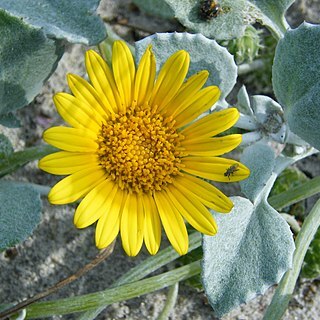Perennial, mat-forming, rhizomatous herb, 20–30 cm high. Leaves slightly succulent, long-petiolate, mostly cauline, broadly ovate to oblate, 2–6 cm long, 1.5–5 cm wide, entire or shallowly toothed, subacute, grey-to white-hairy on both surfaces. Capitula 2–3 cm diam.; peduncles erect, stout, 3–11 cm long; involucre hemispherical or campanulate, 3–4-seriate, 1.5–2 cm diam.; bracts broadly lanceolate, acute; inner ones membranous-margined. Ray florets 12–15; ligules 5–12 mm long, yellow. Disc florets numerous, 3–4 mm long, yellow; lobes c. 1 mm long. Achenes oblong, 3–5 mm long, 1.5–2.5 mm wide, sparsely white-woolly. Pappus scales 6–8, ±obtuse.
Leaves thick-textured, mostly 6–20 cm. long, usually spathulate, expanded in the apical c. 5 and abruptly narrowed below, sometimes ± lyrate; the apical part 2–7 x 2–7 cm., ± broadly ovate or broadly elliptic, sometimes lobed at the base, apex rounded to obtuse, base rounded-truncate to cordate or broadly cuneate, margins subentire to shallowly dentate with callose-tipped teeth, strongly 5–7-nerved from the base; the lower c. 2/3 to c. 11 mm. wide, linear, sometimes widening into 2-many large lobes towards the apex, widening again near the base and somewhat conduplicate.
Decumbent, trailing or suberect perennial herb, up to 300 mm tall. Leaves white felted, thick-textured, usually broadly ovate or elliptic above, abruptly narrowed below, base occasionally lobed, margins ± entire to shallowly dentate with callose-tipped teeth, strongly 5-7-nerved from base. Flowering heads radiate, pedunculate, a few sub-corymbosely arranged in leaf axils; ray florets yellow, neuter; disc florets bisexual, yellow. Cypselas thinly white silky-woolly; pappus of broad, partly fused scales.
Disk-floret corollas yellow, 3–4 mm. long, funnel-shaped with a short tube and a long campanulate limb with lobes c. 1 mm. long; disk-floret achenes c. 5 mm. long, laterally compressed-turbinate, wider than the corolla, finely lanate; pappus cupuliform consisting of a row of broad partly connate scales 0.5–1 mm. deep, membranous or chartaceous.
Involucres 1–1.5 cm. in diam., hemispheric; phyllaries from c. 3 mm. long and broadly triangular outside to c. 10 mm. long and lanceolate-ovate inside, all white-felted to lanate on the back apart from scarious tips and margins.
Mat-forming, white-felted perennial to 10 cm. Leaves petiolate, mostly entire, cordate, margins sparsely toothed. Flower heads radiate, solitary on woolly bracteate peduncles, yellow. Achenes woolly, pappus corona-like.
Stems herbaceous, robust, to c. 1 cm. in diam., prostrate to decumbent, or suberect to c. 30 cm. tall, branched, leafy, producing adventitious roots when buried in sand.
Ray-floret corollas yellow, rays 4–14 mm. long, strap-shaped, 3-denticulate apically; ray-floret achenes to c. 3 mm. long, rudimentary.
Capitula few-many, solitary and terminal on simple or sometimes 1–2-branched axillary stalks up to c. 12 cm. long.
A shortly trailing, tough-fleshy white-felted sometimes sticky perennial herb with a woody taproot.
Receptacle deeply, membranous-walled alveolate.

